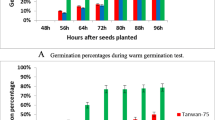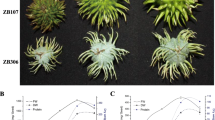Abstract
Seed vigor is influenced by seed position in plant. However, current understanding of its underlying mechanism is limited. In this study, we used isobaric tags for relative and absolute quantitation technique to study the comparative proteomes between middle seeds (with higher vigor) and top seeds of maize (Zea mays L.) ears at 0 h, 24 h, and 48 h of imbibition. A total of 159 differentially accumulated proteins were identified. Among these, the largest number of proteins was from the functional categories of Disease/Defense and Metabolism. Compared with top seeds, most of the differentially accumulated proteins of Protein Synthesis and Energy showed higher accumulation in middle seeds at 0 h and 24 h of imbibition, but lower accumulation at 48 h of imbibition. Seed water absorption activates metabolic processes. The water content of middle seeds was significantly lower than that of top seeds at between 12 h and 30 h of imbibition, but energy production would be higher in the middle seeds at 24 h of imbibition. Meanwhile, tonoplast intrinsic proteins 3.1 and 3.2, which mediate water inflow into protein storage vacuoles, then activating enzymes involved in reserve mobilization, showed higher accumulation in middle seeds at 24 h of imbibition. In addition, our data also showed middle seeds may suffer less fungal damages. Our results contribute to understanding the mechanisms underlying the effects of growth position on seed vigor.





Similar content being viewed by others
References
Bernfeld P (1955) Amylases α and β. Method Enzymol 1:149
Bevan M, Bancroft I, Bent E et al (1998) Analysis of 1.9 Mb of contiguous sequence from chromosome 4 of Arabidopsis thaliana. Nature 391:485
Bewley JD, Bradford KJ, Hilhorst HW, Nonogaki H (2013) Seeds, 3rd edn. Springer, New York
Campo S, Carrascal M, Coca M, Abián J, San Segundo B (2004) The defense response of germinating maize embryos against fungal infection: a proteomics approach. Proteomics 4:383–396
Catusse J, Meinhard J, Job C, Strub J-M, Fischer U, Pestsova E, Westhoff P, van Dorsselaer A, Job D (2011) Proteomics reveals potential biomarkers of seed vigor in sugarbeet. Proteomics 11:1569–1580
Chu P, Chen H, Zhou Y, Li Y, Ding Y, Jiang L, Tsang EWT, Wu K, Huang S (2012) Proteomic and functional analyses of Nelumbo nucifera annexins involved in seed thermotolerance and germination vigor. Planta 235:1271–1288
Cordero M, Raventos D, San Segundo B (1994) Differential expression and induction of chitinases and β-1, 3-glucanases in response to fungal infection during germination of maize seeds. Mol Plant Microbe Interact 7:23–31
Finch-Savage W, Bassel G (2016) Seed vigour and crop establishment: extending performance beyond adaptation. J Exp Bot 67:567–591
Gattolin S, Sorieul M, Frigerio L (2011) Mapping of tonoplast intrinsic proteins in maturing and germinating Arabidopsis seeds reveals dual localization of embryonic TIPs to the tonoplast and plasma membrane. Mol Plant 4:180–189
Gutterman Y (2000) Maternal effects on seeds during development. In: Fenner M (ed) Seeds: the ecology of regeneration in plant communities, 2nd edn. CABI publishing, London, pp 59–84
Hampton JG, Tekrony DM (1995) Handbook of vigour test methods. The International Seed Testing Association, Zurich
Hanson AD, Jacobsen JV (1984) Control of lactate dehydrogenase, lactate glycolysis, and α-amylase by O2 deficit in barley aleurone layers. Plant Physiol 75:566–572
Hunter PR, Craddock CP, Di Benedetto S, Roberts LM, Frigerio L (2007) Fluorescent reporter proteins for the tonoplast and the vacuolar lumen identify a single vacuolar compartment in Arabidopsis cells. Plant Physiol 145:1371–1382
Imai A, Komura M, Kawano E, Kuwashiro Y, Takahashi T (2008) A semi-dominant mutation in the ribosomal protein L10 gene suppresses the dwarf phenotype of the acl5 mutant in Arabidopsis thaliana. Plant J 56:881–890
Jauh G-Y, Phillips TE, Rogers JC (1999) Tonoplast intrinsic protein isoforms as markers for vacuolar functions. Plant Cell 11:1867–1882
Kato M, Shimizu S (1987) Chlorophyll metabolism in higher plants. VII. Chlorophyll degradation in senescening tobacco leaves: phenolic-dependent peroxidative degradation. Can J Bot 65:729–735
Kiesselbach TA (1999) The structure and reproduction of corn, 50th Anniversary Edition. Cold Spring Harbor Laboratory Press, New York
Kirkpatrick B, Bazzaz F (1979) Influence of certain fungi on seed germination and seedling survival of four colonizing annuals. J Appl Ecol 16:515–527
Lamikanra O, Watson MA (2001) Effects of ascorbic acid on peroxidase and polyphenoloxidase activities in fresh-cut cantaloupe melon. J Food Sci 66:1283–1286
Li W, Zhao F, Fang W et al (2015) Identification of early salt stress responsive proteins in seedling roots of upland cotton (Gossypium hirsutum L.) employing iTRAQ-based proteomic technique. Front Plant Sci 6:732
Logan DC, Millar AH, Sweetlove LJ, Hill SA, Leaver CJ (2001) Mitochondrial biogenesis during germination in maize embryos. Plant Physiol 125:662–672
Maurel C, Verdoucq L, Luu D-T, Santoni V (2008) Plant aquaporins: membrane channels with multiple integrated functions. Annu Rev Plant Biol 59:595–624
Melroy DL, Herman EM (1991) TIP, an integral membrane protein of the protein-storage vacuoles of the soybean cotyledon undergoes developmentally regulated membrane accumulation and removal. Planta 184:113–122
Merchante C, Stepanova AN, Alonso JM (2017) Translation regulation in plants: an interesting past, an exciting present and a promising future. Plant J 90:628–653
Misas-Villamil JC, Van der Hoorn RA (2008) Enzyme-inhibitor interactions at the plant-pathogen interface. Curr Opin Plant Biol 11:380–388
Mondo VHV, Cicero SM (2005) Using image analysis to evaluate the quality of maize seeds located in different positions on the ear. Rev Bras Sementes 27:9–18
Novikova GV, Tournaire-Roux C, Sinkevich IA, Lityagina SV, Maurel C, Obroucheva N (2014) Vacuolar biogenesis and aquaporin expression at early germination of broad bean seeds. Plant Physiol Biochem 82:123–132
Obroucheva N, Sin’kevich I (2010) Aquaporins and cell growth. Russ J Plant Physiol 57:153–165
Postaire O, Verdoucq L, Maurel C (2007) Aquaporins in plants: from molecular structure to integrated functions. Adv Bot Res 46:75–136
Shen S, Zhang L, Liang X-G, Zhao X, Lin S, Qu LH, Liu YP, Gao Z, Ruan YL, Zhou SL (2018) Delayed pollination and low availability of assimilates are major factors causing maize kernel abortion. J Exp Bot 69:1599–1613
Shi Z, Fujii K, Kovary KM, Genuth NR, Röst HL, Teruel MN, Barna M (2017) Heterogeneous ribosomes preferentially translate distinct subpools of mRNAs genome-wide. Mol Cell 67:71–83
Simon E (1974) Phospholipids and plant membrane permeability. New Phytol 73:377–420
Soós V, Sebestyén E, Juhász A, Light ME, Kohout L, Szalai G, Tandori J, van Staden J, Balázs E (2010) Transcriptome analysis of germinating maize kernels exposed to smoke-water and the active compound KAR1. BMC Plant Biol 10:236
Sung TY, Delouche JC (1962) Relation of specific gravity to vigor and viability in rice seed. Proc Assoc Off Seed Anal 52:162–168
Turc O, Bouteillé M, Fuad-Hassan A, Welcker C, Tardieu F (2016) The growth of vegetative and reproductive structures (leaves and silks) respond similarly to hydraulic cues in maize. New Phytol 212:377–388
Tyerman S, Bohnert H, Maurel C, Steudle E, Smith J (1999) Plant aquaporins: their molecular biology, biophysics and significance for plant water relations. J Exp Bot 50:1055–1071
Wang W-Q, Ye J-Q, Rogowska-Wrzesinska A, Wojdyla KI, Jensen ON, Møller IM, Song S-Q (2013) Proteomic comparison between maturation drying and prematurely imposed drying of Zea mays seeds reveals a potential role of maturation drying in preparing proteins for seed germination, seedling vigor, and pathogen resistance. J Proteome Res 13:606–626
Wang W-Q, Liu S-J, Song S-Q, Møller IM (2015) Proteomics of seed development, desiccation tolerance, germination and vigor. Plant Physiol Biochem 86:1–15
Wu X, Liu H, Wang W, Chen S, Hu X, Li C (2011) Proteomic analysis of seed viability in maize. Acta Physiol Plant 33:181–191
Xin X, Lin XH, Zhou YC, Chen XL, Liu X, Lu XX (2011) Proteome analysis of maize seeds: the effect of artificial ageing. Physiol Plant 143:126–138
Acknowledgements
We thank Professor Gerhard Leubner, Royal Holloway, University of London, UK, for reading and providing valuable comments on this manuscript.
Funding
This work was supported by the grants from the National Natural Science Foundation of China (31271808 and 31771890) and the National Key Research and Development Program of China (2018YFD0100901).
Author information
Authors and Affiliations
Contributions
YL and CZ planned and designed the research. HQ, PZ, and KS conducted experiments. HQ, YL, and CZ analyzed the data. YL wrote the paper.
Corresponding authors
Ethics declarations
Conflict of Interest
The authors declare that they no conflict of interest.
Electronic supplementary material
Online Resource 1
Plant materials used in the present study. (DOCX 827 kb)
Online Resource 2
Functional classes of differentially accumulated proteins of middle seeds versus top seeds imbibed for 0 h. (XLSX 16 kb)
Online Resource 3
Functional classes of differentially accumulated proteins of middle seeds versus top seeds imbibed for 24 h. (XLSX 18 kb)
Online Resource 4
Functional classes of differentially accumulated proteins of middle seeds versus top seeds imbibed for 48 h. (XLSX 20 kb)
Rights and permissions
About this article
Cite this article
Li, Y., Qu, H., Zhu, P. et al. Comparative Proteomics Reveals the Mechanisms Underlying Variations in Seed Vigor Based on Maize (Zea mays L.) Ear Positions. Plant Mol Biol Rep 36, 738–749 (2018). https://doi.org/10.1007/s11105-018-1115-x
Published:
Issue Date:
DOI: https://doi.org/10.1007/s11105-018-1115-x




